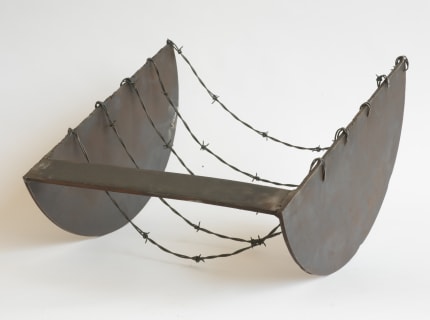“A lynching is a murder, a group murder,” reads the quote from artist Melvin Edwards accompanying his piece, “Nigerian Diamond,” on the ground floor of the Rose Art Museum. This piece, affixed to the wall and made of welded steel, was created in 1978 as part of a series begun over a decade earlier. Edwards’ Lynch Fragments series consists of sculptures made from recovered steel objects and recalls the “metaphorical significance of these items as instruments of oppression,” per the piece’s explanation on the wall at the Rose.
Looking at this small sculpture on the blank white walls of the Rose, I was struck by its simplicity and, frankly, its ugliness. This is not a value judgment — the piece is simply not aesthetically pleasing in a conventional way, nor is it meant to be. It, as well as the others in the series, is meant to be a “powerful [reminder] of the enduring presence and reverberating effects of violence and injustice.”
I did not think I would choose to write about “Nigerian Diamond,” but instead of brushing past it, I spent time with it. I thought of the horror of lynchings and the danger of mob mentality. I felt shame because, even though my ancestors did not commit those atrocities, it is part of my cultural heritage as a white American. I thought about how people are still lynched today, killed or driven to despair by a mob more powerful than them. I will not list every idea I had, but the bottom line is that I had a truly productive and meaningful interaction with this sculpture.
I like art that is pretty or makes me feel good. However, works of art, like people, are not all conventionally attractive, and those which we consider to be ugly are still art and can still make us feel something. Also, as with people, the relative ugliness or attractiveness of a piece is subjective. Additionally, I think that the visual art we find boring or ugly, or the performance art that makes us uncomfortable, or any other confusing work we have come across presents the potential for a more meaningful interaction.
Anyone who has written a Spotlight article or even just been to the Rose will encourage you to go and to see the exhibits on display there. I would like to take it one step further: go to the Rose and spend some quality time with a piece that DOESN’T speak to you. See what happens. It may be nothing, but you’ll never know until you try.
...
Read full article at thejustice.org

